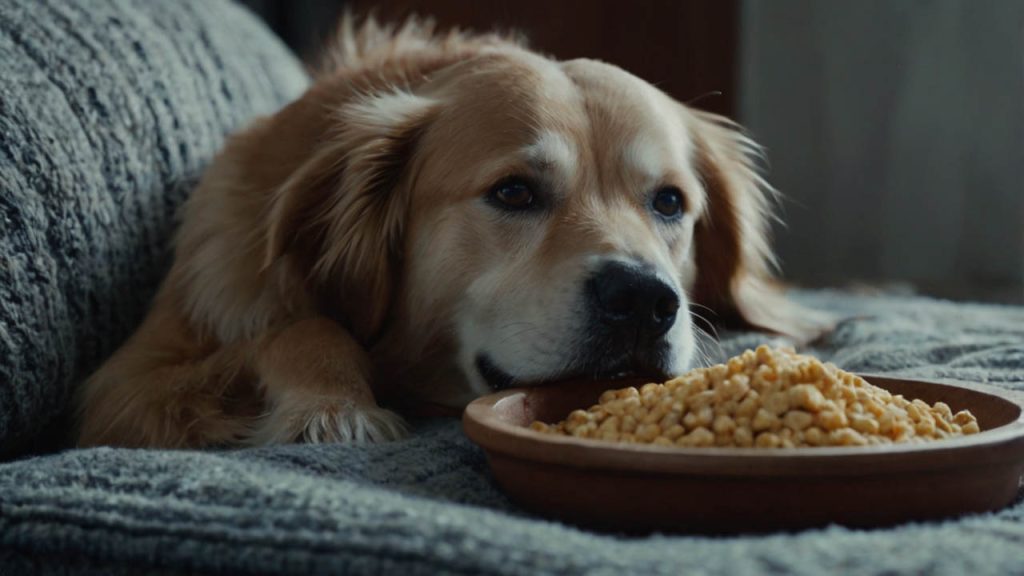Dog Sick What to Feed: Your Step-by-Step Guide to Recovery
It’s a scenario every dog owner dreads: your usually vibrant companion is suddenly unwell, lethargic, and uninterested in their favorite activities. Your immediate concern shifts to providing comfort, which inevitably leads to the critical question, “My dog is sick, what to feed them?” Making the right dietary choice is one of the most important things you can do to support their healing process. However, a sick dog’s digestive system is incredibly sensitive, and offering the wrong food can unfortunately prolong their illness or even make it worse.
This comprehensive guide will walk you through the complete storyline of nutritional care for your sick dog. We’ll start with the non-negotiable first step every owner must take, then build a foundation of supportive care, detail the vet-recommended bland diet, and outline the safe transition back to normal. Consequently, you will be empowered to provide safe, effective, and comforting care for your best friend when they need you most.
The Unskippable First Step: Before Deciding ‘Dog Sick What to Feed’
Before you start cooking or reaching for a remedy, your first and most crucial action is to contact your veterinarian. Sickness is a symptom, not a diagnosis. Only a trained professional can determine the underlying cause of your dog’s illness, which is essential for proper treatment.

Why You Must Call a Veterinarian First
Trying to guess the cause of your dog’s illness is a dangerous gamble. What might look like a simple case of dietary indiscretion (eating something they shouldn’t have) could actually be a sign of a more serious condition. These include pancreatitis, a foreign body obstruction, kidney disease, or a viral infection. Therefore, providing food or medication without a proper diagnosis can mask important symptoms and delay life-saving treatment. This guide on dog sick what to feed is meant to be a powerful tool you use in partnership with your vet, not as a replacement for their professional medical advice.
Recognizing an Emergency: When ‘Dog Sick What to Feed’ Can Wait
Some situations are true emergencies that require immediate veterinary attention. Go to the nearest emergency clinic if your sick dog shows any of these signs:
- Extreme lethargy, collapse, or an inability to stand.
- Repeated, unproductive retching or a hard, bloated abdomen (signs of bloat).
- Visible blood in vomit or stool (can be bright red or look like black, tarry coffee grounds).
- Difficulty breathing, with pale or bluish gums.
- Known ingestion of a toxic substance (like xylitol, chocolate, grapes) or a foreign object.
- Signs of severe dehydration, such as sunken eyes and dry, tacky gums.
Foundational Care When Your Dog is Sick: Comfort and Hydration
While waiting for your vet’s instructions, you can provide foundational supportive care. These steps are safe and universally helpful for any sick dog.
Creating a Restful and Comfortable Environment
First, set up a quiet, warm, and comfortable “recovery zone” for your dog, away from the normal hustle and bustle of your home. Provide soft, clean bedding and ensure they have easy access to a fresh bowl of water. Limiting their movement and providing a peaceful space helps reduce stress, which is a key factor in the healing process.
The Critical Importance of Hydration for a Sick Dog
Dehydration is a primary and immediate danger, especially if your dog is vomiting or has diarrhea.
- Fresh Water: Always have a clean bowl of fresh water available.
- Ice Chips: If nausea prevents your dog from drinking, they may be willing to lick or crunch on ice chips. This is a gentle method to get fluids into their system.
- Bone Broth: Offering a small amount of plain, low-sodium, onion-and-garlic-free bone broth can be a great solution. The appealing aroma often entices a sick dog to drink when they otherwise wouldn’t. This is a great answer for dog sick what to feed when they refuse solid food.
You can perform a quick dehydration check by gently lifting the skin on the back of their neck. If it snaps back quickly, they are likely well-hydrated. If it retracts slowly, they may be dehydrated and need veterinary support.

The Bland Diet: The Core Answer to ‘Dog Sick What to Feed’
Once your veterinarian has given you the go-ahead to offer food, the universally recommended solution is a temporary bland diet. The purpose of this diet is to be gentle, low-fat, and exceptionally easy to digest, giving the gastrointestinal tract a chance to heal.
The Classic Vet-Approved Recipe: Chicken and Rice
This simple two-ingredient meal is the gold standard for a reason.
- Protein: Use boneless, skinless chicken breast. Boil it in plain water until cooked through. Do not add any salt, butter, oil, or seasonings. Once cooked, shred the chicken into small, manageable pieces.
- Carbohydrate: Prepare plain white rice. It is crucial to use white rice, not brown rice. The higher fiber in brown rice can be too harsh for an irritated digestive system.
- The Ratio: The ideal mixture is one part shredded chicken to two or three parts cooked white rice. The higher carbohydrate content provides energy and helps to bind the stool in cases of diarrhea.
Safe Protein and Carb Alternatives for the Bland Diet
If your dog has a poultry allergy or you don’t have chicken on hand, these alternatives are excellent.
- Protein Options: Extra-lean ground beef or turkey (93-99% lean) is a good choice. You must boil the meat and drain all the fat thoroughly. Steamed or baked whitefish (like cod or pollock) also works well.
- Carbohydrate Options: Boiled and mashed potatoes or sweet potatoes (with nothing added) can be used instead of rice.
The Power of Pumpkin When Your Dog is Sick
One of the best additions when considering dog sick what to feed is 100% pure canned pumpkin (not sugary pumpkin pie filling). Its soluble fiber is uniquely beneficial for digestive upset. It can help firm up stool by absorbing water during diarrhea, and it can add bulk to help with constipation, making it a versatile gut-soothing tool. Just a tablespoon mixed into their meal can be very effective.
Addressing Specific Symptoms When Your Dog is Sick
You can tailor the bland diet slightly to better address your dog’s specific symptoms, always under your vet’s guidance.
Dog Sick with Diarrhea: What to Feed for Binding
When diarrhea is the primary issue, the bland diet with a higher ratio of white rice is perfect. The starch in the rice helps absorb excess water in the colon. As mentioned, adding canned pumpkin is an excellent strategy. Furthermore, your vet may recommend a canine-specific probiotic supplement. As research from institutions like the AVMA suggests, probiotics can help restore a healthy balance of gut bacteria disrupted by diarrhea.
Dog Sick with No Appetite: What to Feed to Entice Them
If your dog is nauseous and refuses to eat, you need to make the food more appealing.
- Gently warm the bland diet meal for a few seconds to enhance its aroma.
- Pour a small amount of warm, low-sodium bone broth over the food to create a tempting “gravy.”
- Try hand-feeding small morsels. Your calm presence and encouragement can make a huge difference.
If your dog still refuses to eat, do not force them. Contact your vet again, as they may need to prescribe an anti-nausea medication or an appetite stimulant.
Foods and Medications You Should NEVER Give a Sick Dog
Knowing what to avoid is just as critical as knowing what to provide.
- Dangerous Human Medications: Never give your dog human pain relievers like Ibuprofen (Advil) or Naproxen (Aleve) as they are toxic. Avoid Pepto-Bismol and other human stomach remedies unless explicitly directed by your vet.
- Foods That Will Worsen the Sickness: Do not give fatty, greasy, or spicy foods. Avoid dairy products, as many dogs are lactose intolerant. Do not feed their regular rich kibble or raw food, as these are too difficult for a compromised system to handle.
Conclusion: From Sick Dog to Healthy Companion
When you’re faced with the question of “my dog is sick what to feed,” the answer is a thoughtful, step-by-step process centered on safety and gentle care. The journey always begins with a crucial call to your veterinarian. From there, your focus shifts to providing foundational comfort and hydration, followed by a simple, soothing bland diet once you have the green light. By knowing what to give and, just as importantly, what to avoid, you become an active and effective partner in your dog’s recovery.
Your calm, informed care is the most comforting remedy you can provide, guiding your beloved pet on the quickest path back to their happy, healthy, tail-wagging self.
Have you ever cared for a sick dog? What vet-approved foods or tips worked best for you? Share your experience in the comments below to help other dog owners!


